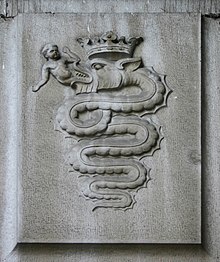Biscione


The Biscione (Italian for ‘large grass snake’), also known as the Vipera (‘viper’ or in Milanese as the Bissa), is a heraldic charge showing in Argent an Azure serpent in the act of consuming a human; usually a child and sometimes described as a Moor. It has been the emblem of the Italian Visconti family for around a thousand years. Its origins are unknown. However it has been claimed that it was taken from the coat of arms of a Saracen killed by Ottone Visconti during the crusades.
The biscione appears also in the coats of arms of the House of Sforza, the city of Milan, the historical Duchy of Milan and Insubria. It is also used as a symbol or logo by the football club Inter Milan, by espresso machine manufacturer Bezzera,by Alfa Romeo and, in a version where a flower replaces the child, by Fininvest.
